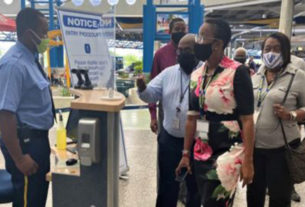BY FABIAN BELGRAVE | MAR 4, 2022 | TOP STORIES

Contractors in the building relief effort were told that 10,000 quality houses needed to be built as Government looks to ramp up production, while taking a second look at in-house procedures to aid contractors.
Minister of Housing, Lands and Maintenance, Dwight Sutherland, disclosed this at a meeting with the National Housing Corporation’s (NHC) independent contractors last evening at the Wildey Gymnasium, Wildey, St. Michael.
Minister Sutherland praised the contractors for being part of the project. “Thank you for coming on board with the Government to address what we call a major problem in this country as it relates to housing. Coming out of the challenges, we met with a freak storm and then Hurricane Elsa,” he said.
He addressed the issue of Government’s social responsibility for citizens in relation to housing solutions after the freak storm and hurricane, and its views in relation to building standards.
“We don’t want to go and put people back into a home that if a category one or two [hurricane] strikes, then they will have challenges again. We said we want to repair their homes to a level of respectability, and that is why we engage all of you here, local contractors and local builders,” Mr. Sutherland stated.
The Housing Minister also outlined some of the Ministry’s concerns. Among them, the rate at which the houses were being built, the “herculean task” of supplying 10,000 housing solutions, and the processing of invoices for the contractors.
“We have 10,000 houses to build…. I believe we can be part of the project, in an effort to address …that poverty index by giving people the opportunity to own their own homes…. We’ll start now and if you average, we need at least 2,000 homes per year…. We can do it.
“We have a physical development plan. Then, we are now creating a housing master plan. And with that housing master plan, we will know where we will be building from St. Lucy to St. Philip. So, I just want you to know that there is a lot of work to be done, but we have to get this Hurricane Elsa freak storm project behind us. Let’s focus on the big picture of building 10,000 houses,” he stressed.
Many of the contractors spoke about two main issues – receiving payment for work completed and inflation, which resulted in high building costs. They noted that late payments made it difficult for them to carry out their operations.
Acting Director of the Rural Development Commission (RDC), Russell Armstrong, spoke about the issue of building costs. “The RDC tracks building costs. We can tell you when the price of material has increased and decreased; how many times, and which product.”
Mr. Armstrong advised the contractors that they should be aware of when and where they purchased their materials. “You really have to be conscious of when you buy your materials, where you buy your materials from, and how you’re executing your work.” He also noted that the costs the contractors were operating with were at current rates.
Financial Controller of the NHC, Pamela Brome, dealt with the late payments by the NHC to the contractors, and outlined that many of the accounts were dormant; the banking information and email addresses were wrong, and pertaining to the issuing of cheques, many contractors did not have a Tax Administration Management Information System(TAMIS) number.




